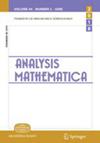拉普拉斯矩阵的伪逆:其迹的渐近性
IF 0.5
3区 数学
Q3 MATHEMATICS
引用次数: 0
摘要
在本文中,我们关注$${\rm{tr}}({\cal L}_{\rm{sq}^+)={1\over4}\sum\limits_{\matrix{{j,k=0}\cr{(j,k)\ne(0,0)}\cr}^{n-1}与正方形晶格,如n→ ∞. 我们在以前的论文中为这种和开发的方法取决于对和的泰勒近似的使用。结果表明,误差项取决于所使用的泰勒多项式是二阶还是更高阶。在这里,我们对具有四阶泰勒多项式的正方形晶格进行了这一操作,从而获得了具有改进的误差项的结果,这可能是最精确的结果。本文章由计算机程序翻译,如有差异,请以英文原文为准。
The pseudoinverse of the Laplacian matrix: Asymptotic behavior of its trace
In this paper we are concerned with the asymptotic behavior of
$${\rm{tr}}({\cal L}_{{\rm{sq}}}^ + ) = {1 \over 4}\sum\limits_{\matrix{{j,k = 0} \cr {(j,k) \ne (0,0)} \cr } }^{n - 1} {{1 \over {1 - {1 \over 2}(\cos {{2\pi j} \over n} + \cos {{2\pi k} \over n})}},} $$
the trace of the pseudoinverse of the Laplacian matrix related with the square lattice, as n → ∞. The method we developed for such sums in former papers depends on the use of Taylor approximations for the summands. It was shown that the error term depends on whether the Taylor polynomial used is of degree two or higher. Here we carry this out for the square lattice with a fourth degree Taylor polynomial and thereby obtain a result with an improved error term which is perhaps the most precise one can hope for.
求助全文
通过发布文献求助,成功后即可免费获取论文全文。
去求助
来源期刊

Analysis Mathematica
MATHEMATICS-
CiteScore
1.00
自引率
14.30%
发文量
54
审稿时长
>12 weeks
期刊介绍:
Traditionally the emphasis of Analysis Mathematica is classical analysis, including real functions (MSC 2010: 26xx), measure and integration (28xx), functions of a complex variable (30xx), special functions (33xx), sequences, series, summability (40xx), approximations and expansions (41xx).
The scope also includes potential theory (31xx), several complex variables and analytic spaces (32xx), harmonic analysis on Euclidean spaces (42xx), abstract harmonic analysis (43xx).
The journal willingly considers papers in difference and functional equations (39xx), functional analysis (46xx), operator theory (47xx), analysis on topological groups and metric spaces, matrix analysis, discrete versions of topics in analysis, convex and geometric analysis and the interplay between geometry and analysis.
 求助内容:
求助内容: 应助结果提醒方式:
应助结果提醒方式:


